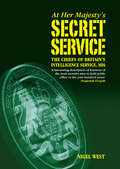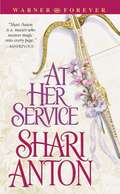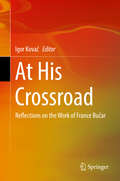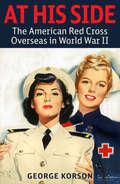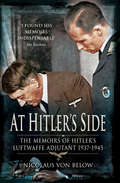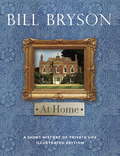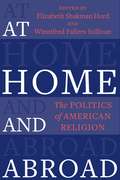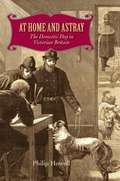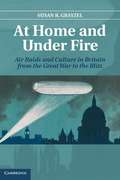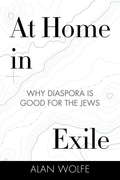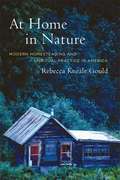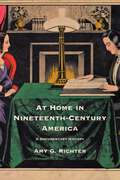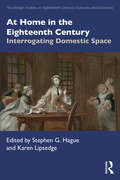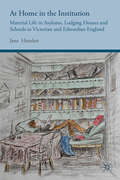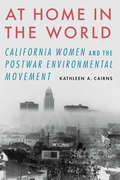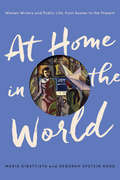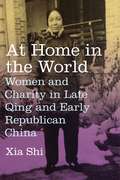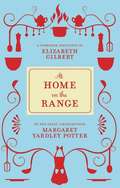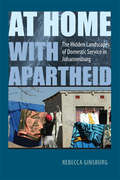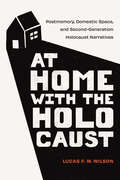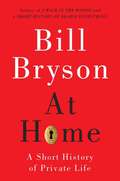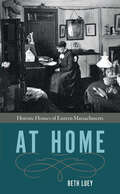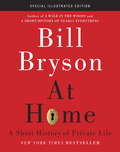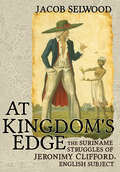- Table View
- List View
At Her Majesty's Request: An African Princess in Victorian England
by Walter Dean MyersTrue story about a 7-year-old African princess who was saved from a ritual sacrifice and taken to England.
At Her Majestys Secret Service: The Chiefs of Britains Intelligence Service, MI6
by Nigel WestIn August 1909, a kindly, balding, figure named Mansfield Smith-Cumming was summoned to London by Admiral Alexander Bethell, Director of Naval Intelligence. He was to assume the inaugural position of Chief – more famously known as ‘C – of what has become
At Her Service
by Shari AntonMercenary Logan Grimm did not work for women, especially not beautiful widows. Therefore, when an agent of Lady Joanna of Lynwood tries to secure his services, Logan turns the offer down. But once he agrees to meet with Joanna, he begins to wonder if he might have been too hasty. The job of ridding Joanna's holdings of a band of thieves would be relatively easy, and staying at Joanna's manor would offer Logan, who had been wounded on his last mission, a comfortable place in which to recoup his strength. The only real difficulty could come from the lady herself, for Joanna is far too beautiful, and far too vulnerable, for Logan to risk getting to know better. After accepting the job, Logan vows to spend as little time as possible with his new employer, but Logan soon finds it difficult to even banish Joanna from his thoughts. Compelling characters and a realistically rendered historical setting come together beautifully in Anton's latest engaging medieval romance.
At His Crossroad: Reflections on the Work of France Bučar
by Igor KovačThis book is a translation and celebration of Slovenian politician France Bučar’s seminal work. Divided into two parts, the book first contains several studies of Bučar’s arguments. As Bučar applied his system theory to a variety of issues, so too the conglomerate of scholars and issues critically assessed is interdisciplinary, ranging from political science and economics, to law and philosophy, as well as to natural sciences. The contributors and the questions of their essays in the edited volume are as follows. Peter Verovsek (University of Sheffield) examines different branches of Critical Theory and classifies Bučar within them. Mark Hamilton (Inter-American Defense College) discusses system dynamics of Bučar’s system theory. Urška Velikonja (Georgetown University) applies Bučar’s system theory to the question of the ethics, rules, and regulations in financial economics. Finally, Matej Drev (Georgia Institute of Technology) connects Bučar to the issue of artificial intelligence and inequality.The second part is the English translation of Bučar’s book At A New Crossroads, which addresses the role of ethics in society. Bučar normatively redefines national identity as the crux of his novel understanding of ethics. Using system theory, he addresses the problems of globalization and governance, presenting a post-modern synthesis of the logic of free flow of capital and global citizenship, with national and cultural identity. Speaking to contemporary society, he shows how society and ethical life are reproduced. Bučar provides the reader with new tools to think about national identity and global politics. Bringing an important work on ethics, government, and identity to an entirely new readership, this book will appeal to a broad academic audience, namely students and practitioners in the fields of economics, social sciences, and humanities.
At His Side: The Story of the American Red Cross Overseas in World War II
by George Gershon KorsonAt His Side, first published in 1945, is the authoritative work on the many important overseas activities of the American Red Cross during the Second World War. From field hospitals, nursing, blood collection, entertainment, to simply providing coffee and fresh doughnuts to exhausted troops, the dedicated workers of the Red Cross were there to save lives and boost morale. The book includes personal accounts of many Red Cross workers involved in all aspects of the Red Cross' overseas wartime efforts, and from all regions of the globe—reports from India, China, North Africa, Guadalcanal, the Philippines, Europe, Australia, Iceland, and more, are presented in a highly readable fashion. Included are 17 maps of the various theaters where the Red Cross operated.
At Hitler's Side: The Memoirs of Hitler's Luftwaffe Adjutant 1937–1945 (Greenhill Military Paperbacks)
by Nicolaus von Below&“An intimate glimpse into the decision-making process of the Nazi military leadership&” from a Luftwaffe aide at Hitler&’s side until the last days in Berlin (Library Journal). Nicolaus von Below was a 29-year-old pilot when Goering selected him for the position of Hitler&’s Luftwaffe adjutant. He was with Hitler at every stage as the Second World War unfolded. His observations tell of Hitler&’s responses to momentous events as well as military decisions and policy-making at headquarters. Published for the first time in English, this is a superb historical source describing life in Hitler&’s inner circle, relied upon by Gitta Sereny in her biography of Albert Speer. The book provides fascinating insight into how Hitler planned the invasions of Poland and Russia; what he thought of Britain and America; why he placed his faith in the V-1 and V-2 projects; how others dealt with him; and much more. Von Below was present at the assassination attempt in July 1944, and records the effect on Hitler and his followers. He was also the last of Hitler&’s close military entourage to emerge from the bunker alive, eventually imprisoned as a material witness at Nuremberg. &“Sure to become an important memoir for those studying the Nazi war machine.&”—Publishers Weekly &“Indispensable.&”—Ian Kershaw, author of Hitler: A Biography
At Home
by Bill BrysonFrom one of the most beloved authors of our time--more than six million copies of his books have been sold in this country alone--a fascinating excursion into the history behind the place we call home. "Houses aren't refuges from history. They are where history ends up." Bill Bryson and his family live in a Victorian parsonage in a part of England where nothing of any great significance has happened since the Romans decamped. Yet one day, he began to consider how very little he knew about the ordinary things of life as he found it in that comfortable home. To remedy this, he formed the idea of journeying about his house from room to room to "write a history of the world without leaving home." The bathroom provides the occasion for a history of hygiene; the bedroom, sex, death, and sleep; the kitchen, nutrition and the spice trade; and so on, as Bryson shows how each has figured in the evolution of private life. Whatever happens in the world, he demonstrates, ends up in our house, in the paint and the pipes and the pillows and every item of furniture. Bill Bryson has one of the liveliest, most inquisitive minds on the planet, and he is a master at turning the seemingly isolated or mundane fact into an occasion for the most diverting exposition imaginable. His wit and sheer prose fluency make At Home one of the most entertaining books ever written about private life.From the Hardcover edition.
At Home and Abroad: The Politics of American Religion (Religion, Culture, and Public Life #44)
by Elizabeth Shakman Hurd and Winnifred Fallers SullivanFrom right to left, notions of religion and religious freedom are fundamental to how many Americans have understood their country and themselves. Ideas of religion, politics, and the interplay between them are no less crucial to how the United States has engaged with the world beyond its borders. Yet scholarship on American religion tends to bracket the domestic and foreign, despite the fact that assumptions about the differences between ourselves and others deeply shape American religious categories and identities.At Home and Abroad bridges the divide in the study of American religion, law, and politics between domestic and international, bringing together diverse and distinguished authors from religious studies, law, American studies, sociology, history, and political science to explore interrelations across conceptual and political boundaries. They bring into sharp focus the ideas, people, and institutions that provide links between domestic and foreign religious politics and policies. Contributors break down the categories of domestic and foreign and inquire into how these taxonomies are related to other axes of discrimination, asking questions such as: What and who counts as “home” or “abroad,” how and by whom are these determinations made, and with what consequences?Offering a new approach to theorizing the politics of religion in the context of the American nation-state, At Home and Abroad also interrogates American religious exceptionalism and illuminates imperial dynamics beyond the United States.
At Home and Astray
by Philip HowellAlthough the British consider themselves a nation of dog lovers, what we have come to know as the modern dog came into existence only after a profound, and relatively recent, transformation in that country's social attitudes and practices. In At Home and Astray, Philip Howell focuses on Victorian Britain, and especially London, to show how the dog's changing place in society was the subject of intense debate and depended on a fascinating combination of forces even to come about.Despite a relationship with humans going back thousands of years, the dog only became fully domesticated and installed at the heart of the middle-class home in the nineteenth century. Dog breeding and showing proliferated at that time, and dog ownership increased considerably. At the same time, the dog was increasingly policed out of public space, the "stray" becoming the unloved counterpart of the household "pet." Howell shows how this redefinition of the dog's place illuminates our understanding of modernity and the city. He also explores the fascinating process whereby the dog's changing role was proposed, challenged, and confronted--and in the end conditionally accepted. With a supporting cast that includes Charles Dickens, Elizabeth Barrett Browning, Thomas Carlyle, and Charles Darwin, and subjects of inquiry ranging from vivisection and the policing of rabies to pet cemeteries, dog shelters, and the practice of walking the dog, At Home and Astray is a contribution not only to the history of animals but also to our understanding of the Victorian era and its legacies.
At Home and Under Fire
by Susan R. GrayzelAlthough the Blitz has come to symbolize the experience of civilians under attack, Germany first launched air raids on Britain at the end of 1914 and continued them during the First World War. With the advent of air warfare, civilians far removed from traditional battle zones became a direct target of war rather than a group shielded from its impact. This is a study of how British civilians experienced and came to terms with aerial warfare during the First and Second World Wars. Memories of the World War I bombings shaped British responses to the various real and imagined war threats of the 1920s and 1930s, including the bombing of civilians during the Spanish Civil War and, ultimately, the Blitz itself. The processes by which different constituent bodies of the British nation responded to the arrival of air power reveal the particular role that gender played in defining civilian participation in modern war.
At Home in Exile
by Alan WolfeAn eloquent, controversial argument that says, for the first time in their long history, Jews are free to live in a Jewish state--or lead secure and productive lives outside it Since the beginnings of Zionism in the twentieth century, many Jewish thinkers have considered it close to heresy to validate life in the Diaspora. Jews in Europe and America faced "a life of pointless struggle and futile suffering, of ambivalence, confusion, and eternal impotence," as one early Zionist philosopher wrote, echoing a widespread and vehement disdain for Jews living outside Israel. This thinking, in a more understated but still pernicious form, continues to the present: the Holocaust tried to kill all of us, many Jews believe, and only statehood offers safety. But what if the Diaspora is a blessing in disguise? In At Home in Exile, renowned scholar and public intellectual Alan Wolfe, writing for the first time about his Jewish heritage, makes an impassioned, eloquent, and controversial argument that Jews should take pride in their Diasporic tradition. It is true that Jews have experienced more than their fair share of discrimination and destruction in exile, and there can be no doubt that anti-Semitism persists throughout the world and often rears its ugly head. Yet for the first time in history, Wolfe shows, it is possible for Jews to lead vibrant, successful, and, above all else, secure lives in states in which they are a minority. Drawing on centuries of Jewish thinking and writing, from Maimonides to Philip Roth, David Ben Gurion to Hannah Arendt, Wolfe makes a compelling case that life in the Diaspora can be good for the Jews no matter where they live, Israel very much included--as well as for the non-Jews with whom they live, Israel once again included. Not only can the Diaspora offer Jews the opportunity to reach a deep appreciation of pluralism and a commitment to fighting prejudice, but in an era of rising inequalities and global instability, the whole world can benefit from Jews' passion for justice and human dignity. Wolfe moves beyond the usual polemical arguments and celebrates a universalistic Judaism that is desperately needed if Israel is to survive. Turning our attention away from the Jewish state, where half of world Jewry lives, toward the pluralistic and vibrant places the other half have made their home, At Home in Exile is an inspiring call for a Judaism that isn't defensive and insecure but is instead open and inquiring.
At Home in Nature: Modern Homesteading and Spiritual Practice in America
by Rebecca Kneale GouldThis study of homesteading in America from the late nineteenth century to the present examines the lives and beliefs of those who have ascribed to the homesteading philosophy, placing their experiences within the broader context of the changing meanings of nature and religion in modern American culture.
At Home in Nineteenth-Century America: A Documentary History
by Amy G. RichterFew institutions were as central to nineteenth-century American culture as the home. Emerging in the 1820s as a sentimental space apart from the public world of commerce and politics, the Victorian home transcended its initial association with the private lives of the white, native-born bourgeoisie to cross lines of race, ethnicity, class, and region. Throughout the nineteenth century, home was celebrated as a moral force, domesticity moved freely into the worlds of politics and reform, and home and marketplace repeatedly remade each other. At Home in Nineteenth-Century America draws upon advice manuals, architectural designs, personal accounts, popular fiction, advertising images, and reform literature to revisit the variety of places Americans called home. Entering into middle-class suburban houses, slave cabins, working-class tenements, frontier dugouts, urban settlement houses, it explores the shifting interpretations and experiences of these spaces from within and without. Nineteenth-century homes and notions of domesticity seem simultaneously distant and familiar. This sense of surprise and recognition is ideal for the study of history, preparing us to view the past with curiosity and empathy, inspiring comparisons to the spaces we inhabit today—malls, movie theaters, city streets, and college campuses. Permitting us to listen closely to the nineteenth century’s sweeping conversation about home in its various guises, At Home in Nineteenth-Century America encourages us to hear our contemporary conversation about the significance and meaning of home anew while appreciating the lingering imprint of past ideals. Instructor's Guide
At Home in the Eighteenth Century: Interrogating Domestic Space (Routledge Studies in Eighteenth-Century Cultures and Societies)
by Karen Lipsedge Stephen G. HagueThe eighteenth-century home, in terms of its structure, design, function, and furnishing, was a site of transformation – of spaces, identities, and practices. Home has myriad meanings, and although the eighteenth century in the common imagination is often associated with taking tea on polished mahogany tables, a far wider world of experience remains to be introduced. At Home in the Eighteenth Century brings together factual and fictive texts and spaces to explore aspects of the typical Georgian home that we think we know from Jane Austen novels and extant country houses while also engaging with uncharacteristic and underappreciated aspects of the home. At the core of the volume is the claim that exploring eighteenth-century domesticity from a range of disciplinary vantage points can yield original and interesting questions, as well as reveal new answers. Contributions from the fields of literature, history, archaeology, art history, heritage studies, and material culture brings the home more sharply into focus. In this way At Home in the Eighteenth Century reveals a more nuanced and fluid concept of the eighteenth-century home and becomes a steppingstone to greater understanding of domestic space for undergraduate level and beyond.
At Home in the Institution: Material Life in Asylums, Lodging Houses and Schools in Victorian and Edwardian England
by J. HamlettAt Home in the Institution examines space and material culture in asylums, lodging houses and schools in Victorian and Edwardian England, and explores the powerful influence of domesticity on all three institutional types.
At Home in the World: California Women and the Postwar Environmental Movement
by Kathleen A. CairnsFrom the beginning of California&’s statehood, adventurers, scientists, and writers reveled in its majestic landscape. Some were women, though few garnered attention or invitations to join the Sierra Club, the organization created in 1892 to preserve wilderness. Over the next sixty years the Sierra Club and other groups gained prestige and members—including an increasing number of women. But these organizations were not equipped to confront the massive growth of industry that overtook postwar California. This era needed a new approach, and it came from an unlikely source: white, middle-class housewives with no experience in politics. These women successfully battled smog, nuclear power plants, piles of garbage in the San Francisco Bay, and over-building in the Santa Monica Mountains. In At Home in the World Cairns shows how women were at the center of a broader and more inclusive environmental movement that looked beyond wilderness to focus on people&’s daily life. These women challenged the approach long promoted by establishment groups and laid the foundation for the modern environmental movement.
At Home in the World: Women Writers and Public Life, from Austen to the Present
by Maria Dibattista Deborah Epstein NordIn a bold and sweeping reevaluation of the past two centuries of women's writing, At Home in the World argues that this body of work has been defined less by domestic concerns than by an active engagement with the most pressing issues of public life: from class and religious divisions, slavery, warfare, and labor unrest to democracy, tyranny, globalism, and the clash of cultures. In this new literary history, Maria DiBattista and Deborah Epstein Nord contend that even the most seemingly traditional works by British, American, and other English-language women writers redefine the domestic sphere in ways that incorporate the concerns of public life, allowing characters and authors alike to forge new, emancipatory narratives.The book explores works by a wide range of writers, including canonical figures such as Jane Austen, Charlotte Brontë, George Eliot, Harriet Jacobs, Edith Wharton, Virginia Woolf, Willa Cather, Gertrude Stein, and Toni Morrison; neglected or marginalized writers like Mary Antin, Tess Slesinger, and Martha Gellhorn; and recent and contemporary figures, including Nadine Gordimer, Anita Desai, Edwidge Danticat, and Jhumpa Lahiri. DiBattista and Nord show how these writers dramatize tensions between home and the wider world through recurrent themes of sailing forth, escape, exploration, dissent, and emigration. Throughout, the book uncovers the undervalued public concerns of women writers who ventured into ever-wider geographical, cultural, and political territories, forging new definitions of what it means to create a home in the world.The result is an enlightening reinterpretation of women's writing from the early nineteenth century to the present day.
At Home in the World: Women and Charity in Late Qing and Early Republican China
by Professor Xia ShiDuring the years spanning the late Qing dynasty and the early Republican era, the status of Chinese women changed in both subtle and decisive ways. As domestic seclusion ceased to be a sign of virtue, new opportunities emerged for a variety of women. Much scholarly attention has been given to the rise of the modern, independent “new women” during this period. However, far less is known about the stories of married nonprofessional women without modern educations and their public activities.In At Home in the World, Xia Shi unearths the history of how these women moved out of their sequestered domestic life; engaged in charitable, philanthropic, and religious activities; and repositioned themselves as effective public actors in urban Chinese society. Investigating the lives of individual women as well as organizations such as the YWCA and the Daoyuan, she shows how her protagonists built on the past rather than repudiating it, drawing on broader networks of family, marriage, and friendship and reconfiguring existing beliefs into essential components of modern Chinese gender roles. The book stresses the collective forms of agency these women exercised in their endeavors, highlighting the significance of charitable and philanthropic work as political, social, and civic engagement. Shi also analyzes how men—alive, dead, or absent—both empowered and constrained women’s public ventures. She offers a new perspective on how the public, private, and domestic realms were being remade and rethought in early twentieth-century China, in particular, how the women navigated these developing spheres. At Home in the World sheds new light on how women exerted their influence beyond the home and expands the field of Chinese women’s history.
At Home on the Range
by Elizabeth Gilbert Margaret Yardley PotterRecently, while moving into a new house, Elizabeth Gilbert unpacked some boxes of family books that had been sitting in her mother's attic for decades. Among the old, dusty hardcovers was a book called At Home on the Range (or, How To Make Friends with Your Stove) by Gilbert's great-grandmother, Margaret Yardley Potter. Having only been peripherally aware of the volume, Gilbert dug in with some curiosity, and soon found that she had stumbled upon a book far ahead of its time. In her workaday cookbook, Potter espoused the importance of farmer's markets and ethnic food (Italian, Jewish, and German), derided preservatives and culinary shortcuts, and generally celebrated a devotion to seeking out new epicurean adventures. Potter takes car trips out to Pennsylvania Dutch country to eat pickled pork products, and during World War II she cajoles local poultry farmers into saving buckets of coxcombs for her so she can try to cook them in the French manner. She takes trips to the eastern shore of Maryland, where she learns to catch and prepare eels so delicious, she says, they must be "devoured in a silence almost devout." Part scholar-she includes a great recipe from 1848 for boiled sheep head-and part crusader for a more open food conversation than currently existed, it's not hard to see from where Elizabeth Gilbert inherited both her love of food, and her warm, infectious prose.Featuring a comprehensive and moving introduction from Potter's great-granddaughter, Elizabeth Gilbert, At Home on the Range is an eminently usable and humorous cookbook. But it's also more than that: it's an heirloom, an into-the-wee-hours dinner with relatives and ancestors, a perfect gift for anybody with a stove or a mother.
At Home with Apartheid: The Hidden Landscapes of Domestic Service in Johannesburg
by Rebecca GinsburgDespite their peaceful, bucolic appearance, the tree-lined streets of South African suburbia were no refuge from the racial tensions and indignities of apartheid's most repressive years. In At Home with Apartheid, Rebecca Ginsburg provides an intimate examination of the cultural landscapes of Johannesburg's middle- and upper-middle-class neighborhoods during the height of apartheid (c. 1960-1975) and incorporates recent scholarship on gender, the home, and family. More subtly but no less significantly than factory floors, squatter camps, prisons, and courtrooms, the homes of white South Africans were sites of important contests between white privilege and black aspiration. Subtle negotiations within the domestic sphere between white, mostly female, householders and their black domestic workers, also primarily women, played out over and around this space. These seemingly mundane, private conflicts were part of larger contemporary struggles between whites and blacks over territory and power. Ginsburg gives special attention to the distinct social and racial geographies produced by the workers' detached living quarters, designed by builders and architects as landscape complements to the main houses. Ranch houses, Italianate villas, modernist cubes, and Victorian bungalows filled Johannesburg's suburbs. What distinguished these neighborhoods from their precedents in the United States or the United Kingdom was the presence of the ubiquitous back rooms and of the African women who inhabited them in these otherwise exclusively white areas. The author conducted more than seventy-five personal interviews for this book, an approach that sets it apart from other architectural histories. In addition to these oral accounts, Ginsburg draws from plans, drawings, and onsite analysis of the physical properties themselves. While the issues addressed span the disciplines of South African and architectural history, feminist studies, material culture studies, and psychology, the book's strong narrative, powerful oral histories, and compelling subject matter bring the neighborhoods and residents it examines vividly to life.
At Home with the Holocaust: Postmemory, Domestic Space, and Second-Generation Holocaust Narratives
by Lucas F. WilsonAt Home with the Holocaust examines the relationship between intergenerational trauma and domestic space, focusing on how Holocaust survivors’ homes became extensions of their traumatized psyches that their children “inhabited.” Analyzing second- and third-generation Holocaust literature—such as Art Spiegelman's Maus, Jonathan Safran Foer's Everything Is Illuminated, Sonia Pilcer's The Holocaust Kid, and Elizabeth Rosner's The Speed of Light—as well as oral histories of children of survivors, Lucas F. W. Wilson's study reveals how the material conditions of survivor-family homes, along with household practices and belongings, rendered these homes as spaces of traumatic transference. As survivors’ traumas became imbued in the very space of the domestic, their homes functioned as material archives of their Holocaust pasts, creating environments that, not uncommonly, second-handedly wounded their children. As survivor-family homes were imaginatively transformed by survivors’ children into the sites of their parents’ traumas, like concentration camps and ghettos, their homes catalyzed the transmission of these traumas.
At Home: A Short History of Private Life
by Bill BrysonBryson takes readers on a tour of his house, a rural English parsonage, and finds it crammed with 10,000 years of fascinating historical bric-a-brac. Each room becomes a starting point for a free-ranging discussion of rarely noticed but foundational aspects of social life. A visit to the kitchen prompts disquisitions on food adulteration and gluttony; a peek into the bedroom reveals nutty sex nostrums and the horrors of premodern surgery; in the study we find rats and locusts; a stop in the scullery illuminates the put-upon lives of servants. Bryson follows his inquisitiveness wherever it goes, from Darwinian evolution to the invention of the lawnmower, while savoring eccentric characters and untoward events (like Queen Elizabeth I's pilfering of a subject's silverware). There are many guilty pleasures, from Bryson's droll prose--"What really turned the Victorians to bathing, however, was the realization that it could be gloriously punishing"--to the many tantalizing glimpses behind closed doors at aristocratic English country houses. In demonstrating how everything we take for granted, from comfortable furniture to smoke-free air, went from unimaginable luxury to humdrum routine, Bryson shows us how odd and improbable our own lives really are.
At Home: Historic Houses of Eastern Massachusetts
by Beth LueyWith its abundant history of prominent families, Massachusetts boasts some of the most historically rich residences in the country. In the eastern half of the Commonwealth, these include Presidents John and John Quincy Adams's home in Quincy, Bronson and Louisa May Alcott's Orchard House in Concord, the Charles Bulfinch—designed Harrison Gray Otis House in Boston, and Edward Gorey's Elephant House in Yarmouth Port. In At Home: Historic Houses of Eastern Massachusetts, Beth Luey uses architectural and genealogical texts, wills, correspondences, and diaries to craft delightful narratives of these notable abodes and the people who variously built, acquired, or renovated them. Filled with vivid details and fresh perspectives that will surprise even the most knowledgeable aficionados, each chapter is short enough to serve as an introduction for a visit to its house. All the homes are open to the public.
At Home: Special Illustrated Edition
by Bill BrysonFrom one of the most beloved authors of our time--more than six million copies of his books have been sold in this country alone--a fascinating excursion into the history behind the place we call home. "Houses aren't refuges from history. They are where history ends up." Bill Bryson and his family live in a Victorian parsonage in a part of England where nothing of any great significance has happened since the Romans decamped. Yet one day, he began to consider how very little he knew about the ordinary things of life as he found it in that comfortable home. To remedy this, he formed the idea of journeying about his house from room to room to "write a history of the world without leaving home." The bathroom provides the occasion for a history of hygiene; the bedroom, sex, death, and sleep; the kitchen, nutrition and the spice trade; and so on, as Bryson shows how each has figured in the evolution of private life. Whatever happens in the world, he demonstrates, ends up in our house, in the paint and the pipes and the pillows and every item of furniture. Bill Bryson has one of the liveliest, most inquisitive minds on the planet, and he is a master at turning the seemingly isolated or mundane fact into an occasion for the most diverting exposition imaginable. His wit and sheer prose fluency make At Home one of the most entertaining books ever written about private life.
At Kingdom's Edge: The Suriname Struggles of Jeronimy Clifford, English Subject
by Jacob SelwoodAt Kingdom's Edge investigates how life in a conquered colony both revealed and shaped what it meant to be English outside of the British Isles. Considering the case of Jeronimy Clifford, who rose to become one of Suriname's richest planters, Jacob Selwood examines the mutual influence of race and subjecthood in the early modern world. Clifford was a child in Suriname when the Dutch, in 1667, wrested the South American colony from England soon after England seized control of New Netherland in North America. Across the arc of his life—from time in the tenuous English colony to prosperity as a slaveholding planter to a stint in debtors' prison in London—Clifford used all the tools at his disposal to elevate and secure his status. His English subjecthood, which he clung to as a wealthy planter in Dutch-controlled Suriname, was a ready means to exert political, legal, economic, and cultural authority. Clifford deployed it without hesitation, even when it failed to serve his interests. In 1695 Clifford left Suriname and, until his death, he tried to regain control over his abandoned plantation and its enslaved workers. His evocation of international treaties at times secured the support of the Crown. The English and Dutch governments' responses reveal competing definitions of belonging between and across empires, as well as the differing imperial political cultures with which claimants to rights and privileges had to contend. Clifford's case highlights the unresolved tensions about the meanings of colonial subjecthood, Anglo-Dutch relations, and the legacy of England's seventeenth-century empire.

